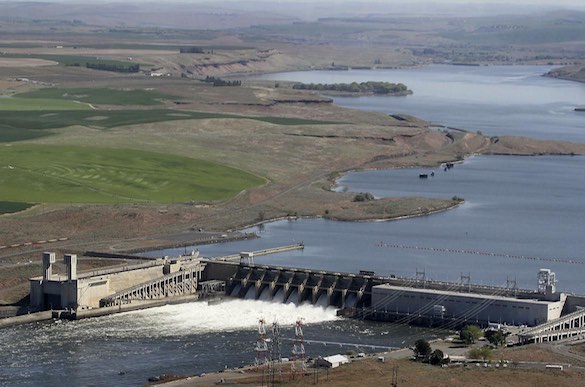forum
library
tutorial
contact

Breaching Dams
Not the Answer
by Nancy Butler
Spokesman-Review, November 3, 2018
|
the film forum library tutorial contact |

|
Breaching Dams
by Nancy Butler
|
"Consider the trillions of dollars it would cost to remove them."
That's what she thinks, it will cost Trillions! See below for actual estimates.
 I have nothing against orca whales. They are beautiful, and they must be saved from extinction. To my delight, I have had orcas swim next to the boat I was in.
I have nothing against orca whales. They are beautiful, and they must be saved from extinction. To my delight, I have had orcas swim next to the boat I was in.
But breaching the dams on the lower Snake River to save them? The idea that orcas' food supply (salmon) suffers because of the dams keeping the salmon from migrating up and down the rivers doesn't tell the whole story.
From the time they enter the Columbia River from the ocean, they face obstacles. Sea lions and Stellar seals feast on them. Fishermen and their boats, even people picnicking, can cause pollution, aka, obstacles.
To help the fish, every dam on the Columbia and Snake rivers has a fish ladder (except Grand Coulee). But the number of salmon that reach a spawning ground is not what it could be if some of the obstacles were eliminated.
Yes, some of the young salmon are caught in the spillway turbulence or in the generators and don't make it past the dams. The rest make it through the obstacles to the ocean, returning as mature fish. The spawning cycle is repeated. Salmon do continue their life cycle in the Columbia and Snake rivers.
Removing the dams isn't the answer. Taking the dams down would be a major blow to the economy of Washington and Oregon. California would suffer because of the power the dams generate and send to that state.
Think about the millions of dollars it cost to build the dams. Then consider the trillions of dollars it would cost to remove them. Who pays for that? You and me, when we pay our taxes.
Project Cost Summary -- FR/EIS Appendix D (February 2002)
Previous estimates of cost have ranged from a high of approximately $5 billion to a low of approximately $600 million. The high cost features of earlier concepts have been eliminated and replaced with features more appropriate considering the available construction methods. The previous low estimates were revised as more details were developed for stabilization, modification, or mitigation measures.
The main difference between this plan and that of the Re-evaluation by DamSense is the "No Catastrophic Drawdown" criteria.)
3. Critical Criteria for Design ConceptsRelated Pages:
. . .
No Catastrophic Drawdown
The evacuation of the reservoirs will be done at a fixed rate of 0.6 meter (2 feet) per day. A higher rate could cause significant slope failures in the reservoirs, putting highways and railroads out of service. Further detailed evaluation of slope materials may allow some modification of this rate. Drawdown rates may vary during the period of drawdown after considering the location of critical embankments relative to the final water surface. An erosion-based method of embankment removal was not considered a feasible option for this study for reasons discussed further in Section 4.2 of this appendix.
What will dam breaching cost? compiled by bluefish for Gov. Inslee's Orca Task Force, 11/18
$350 million estimate by DamSense in Re-evaluation of Appendix D by Jim Waddell, John Twa & Anon Fisheries Biologists / Planners, USACE (February 2016)
Through a careful Re-evaluation of the NWW FR/EIS, a revised channel bypass plan for breaching has been designed that costs significantly less (a 70% reduction) than the NWW near-billion dollar proposal and it can be accomplished in half the time.
The keys to accomplishing a cost and time efficient breaching of each dam are as follows:
Related Pages:
- Very little modification to the power house is needed. The NWW proposal involved significant alterations to the six turbines that even their own data showed was unnecessary to safely drawdown the reservoir.
- Allow the river to do the majority of the embankment removal. The NWW proposal was to mechanically excavate the entire earthen embankment and only allow the river to breach the cofferdams, although it appears that more hydraulic removal of material is required than assumed. Hydraulic breaching has been used numerous times in the Pacific Northwest in the years since the FR/EIS was written and new technology exists to model hydraulic breaching in a safe and predictable manner as was done in this updated plan.
- River channelization can be accomplished using materials already in place at the dam. During dam construction, the natural river channel was successfully routed around the concrete structure without the levees proposed in the FR/EIS.
- Fish handling is unnecessary. Dam breaching will take place at a time when few anadromous fish are present in the river. Hydraulic conditions through the breached embankments will be favorable to fish passage, just as they were during dam construction.
- Minimal reservoir embankment actions are necessary for road/railroad protection and repairs. The NWW proved this during the 1992 drawdown test. In the FR/EIS, NWW planned to spend one hundred times more money on repairing damages to roads and railroads than drawdown actually caused. Drawing the reservoir down at a slower initial rate, as this Re-evaluation recommends, will further reduce the minimal damage that occurred in the 1992 test.
- Lyons Ferry Hatchery should not be modified as the NWW's plan proposes.
- Since Channel Bypass was selected and this plan simply improves on it at lower cost, this plan is consistent with the existing Environmental Impact Statement for the overall project.
What will dam breaching cost? compiled by bluefish for Gov. Inslee's Orca Task Force, 11/18
learn more on topics covered in the film
see the video
read the script
learn the songs
discussion forum
